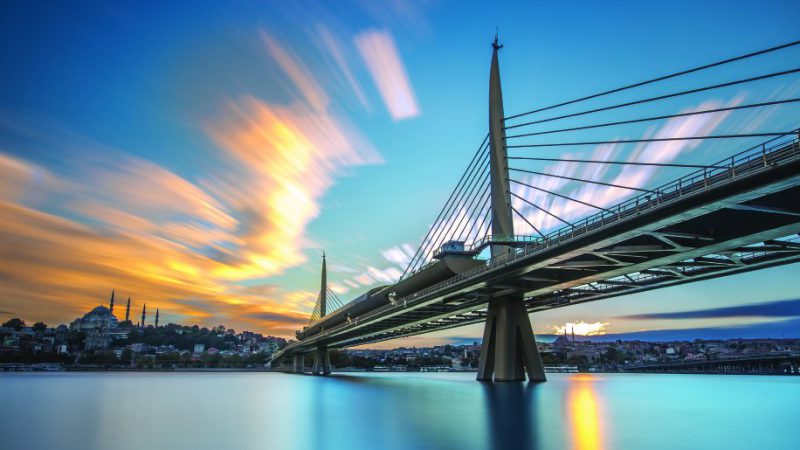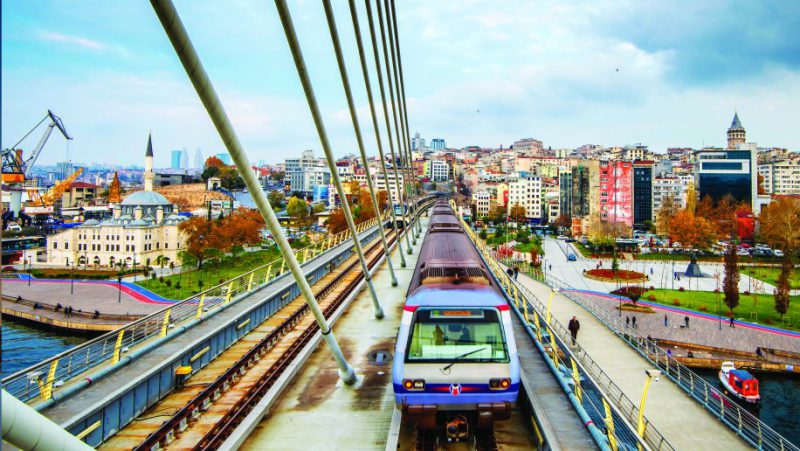Building Bridges
Along with its new airport, Turkey’s biggest city has seen a raft of improvements that are bolstering its appeal as a business and leisure destination
January 30, 2020

The past year has been a watershed one for Istanbul. The city’s tourism sector is recovering from the troubles of 2016, with arrivals for 2019 expected to have topped 15.5 million by the year’s end (according to Istanbul chamber of commerce president Sekib Avdagic), up from 13.4 million in 2018. Hotel occupancy in the peak month of August, meanwhile, reached 87.7 percent – 4.4 percent up on 2018, and 10 percent above the European average – according to the Hotel Association of Turkey.
On June 23, a new young city mayor from the main secular opposition party was elected under the slogan “Her sey cok guzel olacak” (Everything’s going to be great). One of the first ways that Ekrem Imamoglu is seeking to achieve his aim is by swiftly setting about reforming the city’s cumbersome and opaque bureaucracy, which sees many services delivered through a tangle of city-owned companies and allegations of soft contracts being awarded to companies close to Turkey’s governing AK party.
Host City
Imamoglu has a good platform for these changes. Close to two decades of investment has overhauled the city’s infrastructure and brought a sea change in the hospitality and retail sectors. Gone are most of the backpacker hostels; instead, Istanbul now boasts 220 four- and five-star hotels, with a further 54 scheduled to open in the coming years.
“We’re one of the most competitive cities on price – visitors spend an average of $90 per night for a room compared with $166-220 [elsewhere] in Europe,” says Cemil Hakan Kilic, chief executive of the Istanbul Convention and Visitors Bureau (ICVB). Investments in hotel development isn’t just confined to the city center or the main tourist spots of the Bosphorus – even the grayest outlying industrial and business districts now boast high-end branded hotels.
Also transformed is Istanbul’s dining scene, no longer confined to the traditional regimen of kebabs, fish and bar food, it now covers all the bases from sushi to vegan. Change has come both organically and thanks to local restaurant management groups such as D-Ream, whose portfolio of 52 upmarket restaurants such as La Petite Maison (French), Lacivert (fresh fish and seafood in a restored Bosphorus mansion) and Fenix (American and Japanese) employs internationally trained chefs and offers diner-friendly online booking.
The retail sector, too, is developing apace. The world-famous Grand Bazaar is still there but the city also has myriad new shopping malls boasting a full range of international outlets alongside the best homegrown brands.
There’s more to come in 2020, with the expected opening of the $700 million Galataport complex, a state-of-the-art cruise ship terminal being built on a stretch of derelict central Istanbul dockland. Capable of simultaneously handling four of the largest (Oasis class) vessels and up to 15,000 passengers a day, it will also have 560,000 square feet of retail space and 463,000 square feet of offices. It is expected to welcome up to three million tourists a year, and to spark the redevelopment of the surrounding historical port district.
Business Hub
As Turkey’s biggest city and the country’s financial and business center, Istanbul pretty much controls the Turkish economy. Home to 56 universities and seven technology parks, it is also the incubator and hub to much of the innovation that has driven the country’s rapid growth over the past three decades.
It’s no surprise, then, that it has also been making a name for itself as a major center for global business meetings. In 2017 the city hosted 143 international congresses, conferences and meetings totaling more than 115,000 participants, plus 163 national events attended by a further 34,000 delegates, although the ICVB will not release 2018 figures, perhaps because of the number of cancellations for that year. As a sector that organizes up to five years ahead, it is particularly prone to external shock – 2016 saw Istanbul play unwilling host to a failed military coup, and some terror attacks, and while in the main most of the city has always remained resolutely safe, bad news travels fast and does affect business.
“Five years ago we were one of the top ten congress cities in the world but ‘external factors’ sent us back down again,” Kilic says. However, he confirms that business has finally been picking up again. “Hopefully next year we’ll be back in the top ten and remain there for good,” he adds. The challenge, he explains, is to ensure steady growth and minimize fluctuations, adding that the variety and quality of the city’s modern facilities gives it an edge over its European competitors.
Investing for Growth
In addition to dozens of high-end hotels with meeting facilities, Istanbul has seven dedicated convention centers and three exhibition venues. A short stroll from the central Taksim Square, the city’s “Congress Valley” boasts two huge complexes: the Istanbul Congress Centre and the Lutfi Kirdar International Convention and Exhibition Centre, which together can handle up to 30,000 delegates and which hosted the World Energy Congress 2016 and the World Petroleum Congress 2017. A short drive from here is the 1,000-capacity Grand Cevahir Hotel and Convention Centre and the sprawling Halic Congress Centre, located on the shores of the Golden Horn.
“Infrastructure-wise, we can give everything any other city can and more – our venues are newer and state-of-the-art,” Kilic says, adding that its meetings business boosts the city’s reputation in more ways than one. “Congresses have a multiplier effect – they bring top-level educated and influential people, and when they return home their word-of-mouth recommendation carries weight.”
Speedy Ascent
Istanbul’s rapid modernization has coincided with the equally speedy expansion in air traffic both to and through the city’s two airports. Key to that has been the realization that its geographical location between the European and South and East Asian passenger markets makes it a natural regional hub with significant advantages over competing airports in the Gulf. That has placed more than two billion people within six hours’ flight time of the city, and has led to a seismic growth in transit traffic.
The rebirth of state-controlled national carrier Turkish Airlines is well known, helped by its membership of Star Alliance. It is now one of the fastest-growing and most successful airlines in the world, boasting a young fleet of 346 aircraft flying to 312 destinations in 124 countries plus 50 more inside Turkey. In 2018, it carried 75.2 million passengers – a 330 percent increase over the decade.
Also expanding is Pegasus Airlines. Since its purchase in 2005 by Turkey’s ESAS Holding and its relaunch as a budget carrier, Pegasus has grown to operate a fleet of 83 planes to 39 domestic and 70 international destinations, including most major European capitals. And while its prices may be low, the airline also offers special business packages with a range of add-ons.
All of this rapid growth left Istanbul’s two airports struggling to cope, so the opening of the all-new $6 billion Istanbul airport in April 2019 was much needed. When all phases are complete in 2027, it will be the biggest, and possibly busiest, in the world, boasting six runways and four terminals capable of handling a hefty 200 million passengers a year.
While it has been criticized for its size and negative environmental impact, its greatly improved facilities (compared with Ataturk airport, now closed to commercial flights) and reduced delays have meant that passenger feedback has been mostly positive.
The one serious gripe – the 25-mile bus ride out of town – is set to be addressed in mid-2020 with the completion of a high-speed metro link that will cut the commute to 33 minutes. And with another metro line to Istanbul’s second airport, Sabiha Gokcen, also due next year, the two airports will be linked both to each other and to all points across the city by rail.
Linking Up
Investment has also been plowed into the rest of the city’s transport infrastructure. The journey time between the European center and the heart of Istanbul’s Asian side has been improved thanks to a new road tunnel under the Bosphorus, complementing the two existing road bridges. Meanwhile, a network of tunnels on the European side has cut journey times between the main suburbs, and the recently opened Yavuz Sultan Selim road bridge offers the chance to bypass most of the city altogether.
Then there is the new high-tech metro and tram network: 2019 saw the final completion of the 48-mile “Marmaray” suburban rail system, linking 43 stations on the two continents via a tunnel under the Bosphorus, forming the backbone of a network that already boasts seven underground metro lines, four overground tramways and three funicular rail lines.
“It’s fast, clean, safe and it’s no exaggeration to say that it has revolutionized travel in Istanbul,” says Turkish transport analyst and infrastructure engineer Ergin Buyukbayramoglu, who hails the decision by Mayor Imamoglu to commence round-the-clock operations on parts of the network as visionary.
“It’s just what we need – a transport network that never closes, for a city that never sleeps,” he laughs. Construction of another 11 metro lines and a tram line is under way, as is work on upgrading intercity rail lines to carry 124 mph high-speed traffic.
The Marmaray network already carries high-speed traffic from the capital, Ankara, and the western city of Konya, allowing trains to terminate at a new main rail terminal on the western side of the city. In 2020, high-speed links will be commissioned between Istanbul and Turkey’s Aegean capital of Izmir, as well as to Sivas, Samsun and other cities across Anatolia. Also under way, with the help of a $305 million EU grant, is the rebuilding of the main rail line from Europe, which, when completed in 2023, would allow direct uninterrupted rail transit from the north of the UK across Europe to Istanbul, and to all points east as far as China, which promises to transform Istanbul into an import rail freight hub.
Whether trains will ever run between the UK and China via Istanbul remains to be seen, but given Turkish ingenuity and entrepreneurial spirit, few would bet against it happening one day.






